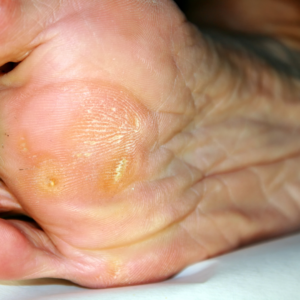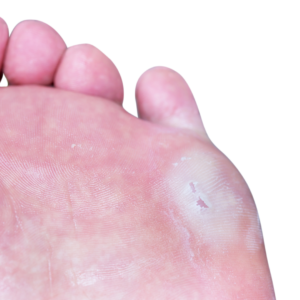- 404-363-9944
- Mon - Thur 8:00 - 5:00
- Fri 8:00 - 4:00
- Four Convenient Locations In Atlanta
Corns: The Uncomfortable Formation
Scientifically referred to as helomas, corns, are hardened layers of skin surrounded by inflamed skin. They usually occur on the tops and sides of toes in areas of little pressure or non-weight bearing areas. Helomas can be painful when pressed, resulting in a dull ache.
Types of Corns
Hard Corns (Heloma Durum): Hard corns are the most common type, located on toes and usually developing due to poorly fitted shoes. The anatomical structure of the toes forces the tops of the toes to push towards the top of shoe toe box: thus, resulting in a hard heloma. These small, “pebble-like” layers of skin cause deep tissue damage and are generally caused by abnormal pressure areas such as the bottom of the big toe and the base of the 2nd toe.

Soft Corns (Heloma Molle): Soft corns are found between the toes. In particular, more often between the fourth and fifth toe. Due to the continuous softening by sweat, they are whiter and softer in appearance. These cause deep tissue pain and possible ulceration.

Causes of Corns
Ill-fitting shoes are the single largest cause of toe corns. Specifically, shoes that are too small, too tight, and/or have a narrow, elongated toe box, put extra pressure on the joints of the toe. Other sources of pressure and friction include:
- Bunions
- Hammertoe
- Pre-existing foot deformities
- Not wearing socks
Prevention
You can prevent helomas by:
- Wearing shoes that properly fit. If you cannot wiggle your toes, your shoes are too tight.
- Use protective coverings. Felt pads, nonmedicated pads, or bandages can be used to cover areas that rub against your shoes.
Treatment
The physicians at American Foot & Leg Specialists offer several options for treating corns. Our first assessment is making sure that you are wearing properly fitted shoes. Addressing this problem can be all it takes to get rid of the issue. However, it is sometimes necessary to take other measures. Such measures include using medicated pads or salicylic acid, which pares the heloma. Patients can also apply an exfoliating foot cream to the affected area. You apply this liberally and wear it overnight to moisten the hard corn, making it easier to remove. Patients with diabetes should allow one of our physicians to evaluate and assess the condition.

